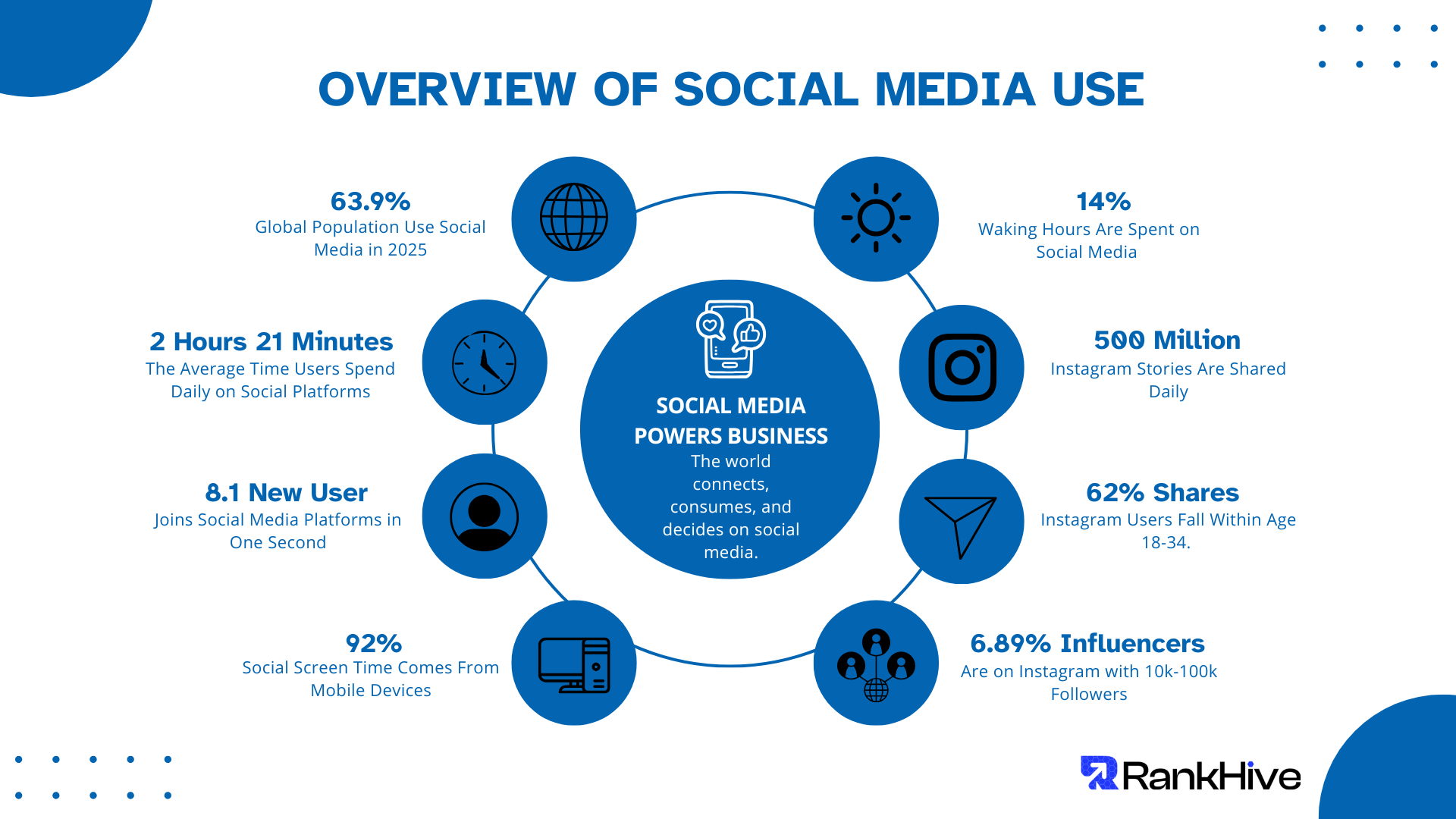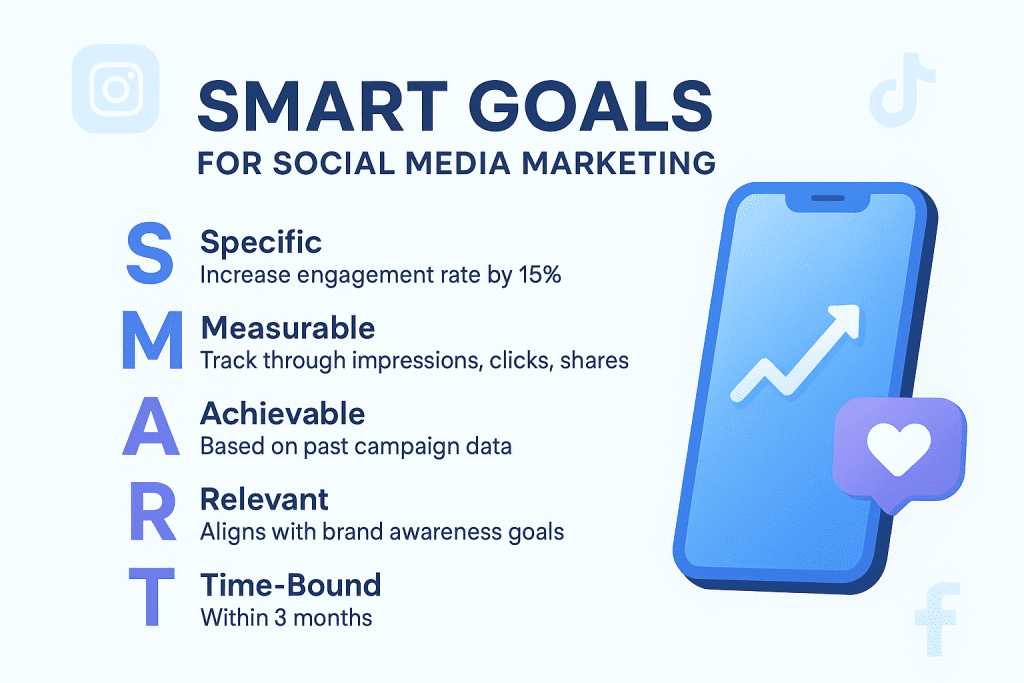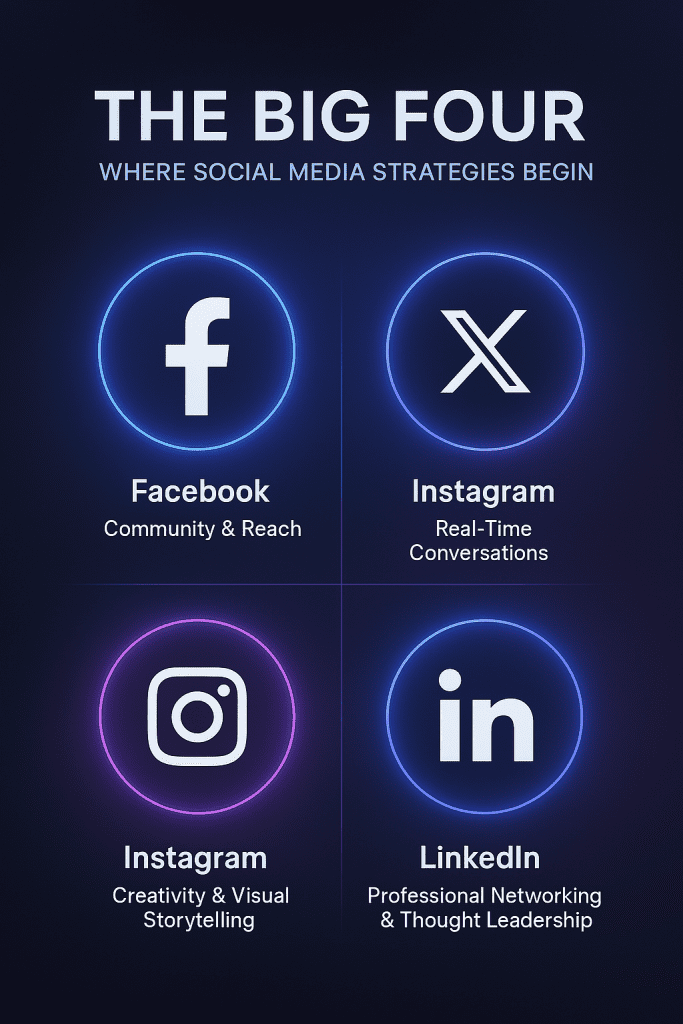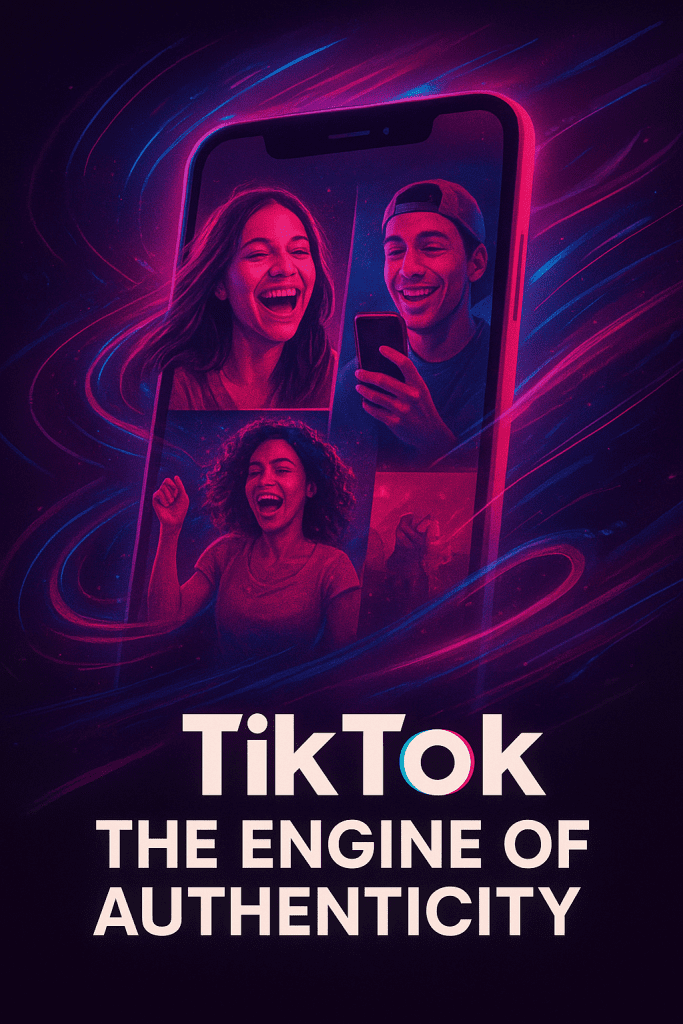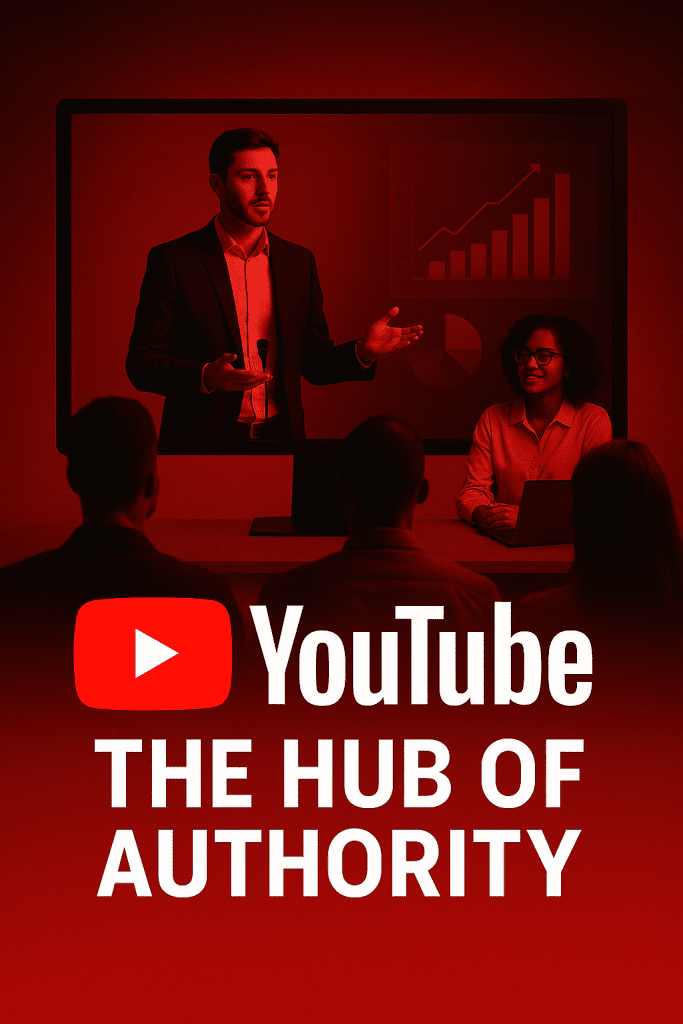Two hours and twenty-one minutes.
That’s not a random number, it’s the world’s daily social media obsession.
According to DataReportal (via DemandSage), this is the average amount of time the world’s over 5.4 billion social media users spend scrolling, viewing, and engaging every single day.
Social media is no longer a luxury for brands; it is the single largest concentration of consumer attention in human history.
In simple words, the world is on social media, and if your brand isn’t there, you are invisible to over half the planet. This guide to digital and social media marketing will help you get familiar with the subtle nuances.
It’s a guide that explains how you can put together your winning social strategy.
What is Social Media Marketing (SMM)?
Social Media Marketing (SMM) is the strategic process of creating, publishing, and optimizing content across platforms like Instagram, TikTok, LinkedIn, and Facebook.
The purpose of digital and social media marketing is to build your brand, drive website traffic, increase sales, and create authentic customer relationships.
It is the discipline of treating social channels not just as places to post ads, but as dynamic storefronts, customer service desks, and R&D labs.
Why Do Brands Need an Ultimate Social Media Guide?
With platforms always shifting algorithms, content formats, and advertising rules, today many brands feel lost. Such complexities leads to major questions such as:
- Should you prioritize video on TikTok or long-form posts on LinkedIn?
- How do you run paid ads without wasting budget?
- How do you measure a “like” and translate it into actual revenue?
Brands need a more comprehensive and reliable resource that cuts through the noise.
This isn’t just a list of tips; it’s a blueprint for growth which we have specifically designed to build you a durable, profitable and future proof social media presence.
This ultimate guide will provide you with the foundational strategy and tactical expertise necessary to master Digital and Social Media Marketing for Brands.
Foundational Strategy – Building Your SMM Blueprint
The start of any successful digital and social media campaign isn’t posting, it’s planning.
Therefore, we have put together a foundational strategy which establishes the critical groundwork to ensure your brand’s activity on social media drives business, not just satisfy vanity metrics.
Define Your Goal – The SMART Framework
Why Setting SMART Goals Matter in Social Media?
SMART goals determine how you measure Return on Investment (ROI) of your social media efforts. Your digital and social media goals can be common such as brand awareness (tracked in the form of Reach/Impressions), lead generation (tracked in the form of Clicks/Sign-Ups) or simply customer service (tracked in the form of Time/Satisfaction Score).
Or they can be more specific, such as increasing repeat purchases through remarketing campaigns, improving engagement rates by 20% within a quarter, driving app installs from a new audience segment, boosting video completion rates to increase storytelling impact, or nurturing loyal customers into brand advocates through personalized retention strategies.
You can’t manage what you don’t measure.
In our opinion, setting vague goals like “get more followers” is a recipe for wasted effort. Therefore, it’s important to use the SMART framework to define specific goals.
| Component | What It Means | Example |
| Specific | Clear, defined, and addresses one objective. | Not “Improve brand awareness,” but “Increase brand visibility on Instagram.” |
| Measurable | Quantifiable with a Key Performance Indicator (KPI). | Not “Get more comments,” but “Achieve an engagement rate of 6%.” |
| Achievable | Realistic, based on your current resources and performance. | Don’t target a million followers if you currently have 1,000. |
| Relevant | Aligned with the company’s bigger business goals (e.g., revenue). | Improving customer service on social media to boost retention. |
| Time-bound | Must have a clear deadline. | “Increase post reach by 25% on Facebook over the next three months.” |
Who is Your Audience? (Building Personas)
If you want to create content that connects, you must know exactly who you’re talking to.
This can be achieved by creating detailed Buyer Personas for social media.
Start with a semi-fictional profile based on real customer data.
According to Research conducted by Delve AI, companies with formally documented personas are 71% more likely to surpass revenue targets.
When you design your digital and social media personas, it helps you with:
- Platform Choice: Where does your audience actually spend their time (e.g., is your B2B customer on LinkedIn, or is your younger target on TikTok)?
- Content Preference: What formats do they engage with most (video, polls, threads)?
- Pain Points: What problems do they need your brand to solve?
All of this data helps you personalize content to address your persona’s specific needs. It makes your overall brand messaging more impactful and eventually much more relevant.
Competitor Analysis (Social Media Benchmarking)
After all, your digital and social media strategy is incomplete unless you know who you’re up against. It’s why having a competitor analysis on social media is important. It works as your intelligence report involving systemic reviews of your rival strategies. You can choose particular rivals or you can compete against similar businesses who are vying to grasp your audience’s attention.
This process is called social media benchmarking.
The competitor analysis will help you uncover:
- What’s Working: Which of their posts, campaigns, and hashtags drive the highest engagement rates?
- Platform Priority: Where are they dedicating the most time and resources?
- The Content Gap: What topics or content formats are they neglecting?
According to HootSuite, analyzing what your rivals are doing smartly and poorly is important to identify content gaps and opportunities. This lets you differentiate your brand and design a worthwhile strategy to win audience share instead of copying what everyone is doing.
Platform Deep Dive – Choosing & Mastering Your Channels
Done with setting SMART goals? It’s now time to move from strategy to execution.
Find where your audience spends most of their time, and most importantly why they are there. In this section, we will understand the core platforms, their primary purposes & how to create content that speaks the native language of every channel.
The Big Four – Core Platforms & Their Purpose
The digital and social media landscape is transformative. It means the trends on these platforms are constantly changing. However, four of these platforms serve as the foundation for most brands.
Each serves a different user mindset.
| Platform | Primary User Mindset | Core Content Focus | Brand Opportunity |
| Aesthetic/Inspiration | Visuals, Reels (Short Video), Stories | Visual Storytelling & E-commerce. Ideal for fashion, food, lifestyle, and any brand that relies on strong aesthetics. Its format prioritizes polished content and product discovery, with shopping features enabling direct sales (Source: Zebracat AI). | |
| Community/Connection | Groups, Long-form Posts, Targeted Ads | Community Building & Paid Advertising. Excellent for nurturing niche customer communities via Groups. With powerful targeting tools, it remains the most robust platform for cost-effective ad campaigns and awareness at scale (Source: Mayple). | |
| X (formerly Twitter) | Real-Time/News | Short Text Posts, Live Updates, Threads | Real-Time Engagement & Customer Service. The fastest channel for news, cultural moments, and direct, conversational interaction. Brands use it for quick announcements, viral commentary, and fast public resolution of customer issues (Source: DemandSage). |
| Professional/Learning | Articles, Native Documents, Deep Insights | B2B Marketing & Thought Leadership. This is the digital conference room. Users seek professional development and industry insight. Brands leverage it to publish authoritative articles, showcase company culture, and position executives as industry thought leaders (Source: Edelman-LinkedIn). |
Emerging & Niche Platforms
The “Big Four” cover broad bases. However, there are specialist platforms which are essential for brand targeting. Each follows specific consumption habits backed by proven visuals.
TikTok – The Engine of Authenticity
TikTok features ultra-short form entertaining videos which are under 60 seconds. They cover a broad range of topics mostly trends, music and raw authenticity.
Why is TikTok important? It opens brand opportunities through viral reach & trendjacking. TikTok’s algorithm prioritizes discovery over follower count.
As Teleprompter.com puts it, for small brands, it means massive organic reach through content that feels real, unpolished and human performed.
Pinterest – The Visual Search Engine
Pinterest is mostly based upon visual search. It focuses on image collections in the form of Pins.
Pinterest matters because this social platform is where users scroll passively for hours planning stuff like home renovation, trips, meals and so on. Since the platform has a high purchase intent, it becomes a powerful channel for driving traffic to any e-Commerce site generating sales.
YouTube – The Hub of Authority
YouTube primarily focuses on long-form video content. You can easily find tutorials, documentaries, and live streams on YouTube for your specific requirements.
YouTube videos are SEO focused and dispatch deep education. It’s the world’s second-largest search engine after Google. The long-form videos built here are based on trust & positions as an expert in the field. You can optimize video titles, descriptions and transcripts to rank on searches through Video SEO. It ranks content the same way as Google Search for evergreen queries.
The Content Matrix – Matching the Content Platform
The biggest mistake a brand can make is posting the exact same content across all channels.
This practice is known as “recycling.”
If you’re running an effective brand, use a Content Matrix based on repurposing, not recycling.
How is Repurposing Different?
Repurposing takes one powerful idea and makes it adaptable to fit the culture and format of different channels. It maximizes the content’s life and efficiency on social media.
In repurposing, you’re not putting the same square graphic with the same caption on different channels like Facebook, Instagram and LinkedIn. Instead, you’re creating native formats for different platforms.
Here’s a content matrix for how you can repurpose format for original pieces:
| Original Content Piece | Repurposed Format | Platform & Mindset |
| 3,000-word E-book | 10-slide visual carousel | LinkedIn (Professional learning) |
| 1-hour YouTube Tutorial | 3 x 30-second clips (with captions) | TikTok / Instagram Reels (Entertainment, Quick Tips) |
| Customer Case Study | A short-form Q&A video | Facebook (Community/Proof) |
| New Blog Post | A series of rapid-fire tips in a thread | X (formerly Twitter) (Real-Time News/Digestible Info) |
Content Creation – The Heart of Social Media Marketing
Content is the bridge between your brand and audience.
If you want to stand out in social media, you need a practical framework that works.
High-quality content isn’t just wordplay, it’s how you align them to meet your strategic goals.
When it comes to social media, content marketing is specified into four core categories.
| Pillar | Purpose | Example (for a coffee brand) |
| 1. Educational | Establishes authority and provides value. | “How-To Brew Guides,” “The Science of Coffee Bean Roasting.” |
| 2. Entertaining | Captures attention and encourages sharing. | “Coffee Memes,” “Funny ‘Monday Morning’ Skits” (short video). |
| 3. Inspirational | Relates to lifestyle and emotional connection. | “Morning Routine Goals,” “Sustainable Sourcing Journey” (values). |
| 4. Promotional | Drives specific actions (sales, sign-ups). | “Limited-Time Offer,” “New Product Launch Announcement,” “Contests.” |
Mastering Different Content Formats
Every content format mentioned above comes with its unique strength.
And it’s your job to ensure which format you can use to strategically maximize engagement.
Video (The King of Reach)
Short-Form Video (Reels, TikTok) – Currently, the short-form videos are dominant. If you’re using a smartphone, there’s a high chance you’re going to skip watching a vertical video scrolling up/down. If you want to grasp user attention, you can focus on a strong hook, one that captures the audience’s attention in just 3 seconds.
Long Form Video (YouTube, Facebook Live) – Long form content, on the other hand, is great for individuals who want to take a deeper dive. These can be product demonstrations, & comprehensive tutorials. Certain creators run Live Video to build powerful audience relationships & establish trust through real-time Q&A sessions.
Imagery (Visual Impact)
High Quality Images – Another way to win your audience is setting your perfect visual identity and you can do it by sharing high quality images essentially for Instagram & Pinterest.
Graphics (Infographics/Quotes) – You can create digestible & shareable content which you can publish as infographics and quotes to convey your message in the best limelight.
Carousels (The Slide Show) – Last but not the least, Carousels are swipeable posts highly effective and work great on platforms Instagram & Linkedin to spend time.
Text/Copy (The Hook and the Close)
Aside from visuals, your copy must be compelling to win your target audience. There are a few things you need to consider when writing a digital and social media copy.
The Hook: The first sentence of every caption you write must be valuable. It can be provocative, ask a question, pose a shocking statistic or encourage the user to click, “See More.”
Call-to-Actions (CTAs): Every post you cover should come with a clear purpose. After all, you want to tell your audience exactly what they need to do or else they will stay confused.
Using Emojis: Lastly, emojis set the tone of voice on social media. You can use them to break up dense text, inject personality and convey emotions.
Authenticity & Trends
Today’s audiences, especially Gen Z, are fatigued with watching overly polished and highly advertised content. They want more authenticity & relevance in the social content they consume.
Why Polished Content Doesn’t Work Anymore? – It’s because audiences often scroll past such content and consider it as a traditional advertisement. Content which comes as too perfect often lacks the human element and drives less connection and trust. It’s one of the reasons why user-generated content (UGC) works better. Even Google & ChatGPT cites sources from Quora & Reddit created by individuals instead of brands. UGC is something that shows authenticity & anything that comes off as authentic (posts, reviews, or videos) acts as a social proof. Ultimately, it becomes a better form of branding leading to more genuine engagements.
Why Participating in Trend Works? – On the contrary, trends such as popular sounds on TikTok or specific meme formats on X have become the new norm. The key to success is to simply participate in relevant trends without losing your brand voice. For example, a finance brand can’t participate in a dance challenge, but they can capitalize on the format and sound to deliver a quick, entertaining financial tip. Someone may find that financial tip engaging because they came across this particular format and sound hundreds of times on social media.
Stay Consistent & Follow a Schedule
This may come off as a surprise, but consistency doesn’t mean posting digital and social media posts 10 times a day. It means reliably showing up for your audience when they expect you.
You can do it by:
Setting Up an Editorial Calendar – Utilize your content pillars to plan at least two weeks of social posts in advance. A calendar prevents panic-posting & ensures a balanced mix of themes & published formats.
Using a Scheduling Tool – Today, we have tools like Hubspot, Buffer or Sprout Social for content creation & publishing. You can use any scheduling tool of your choice; schedule them on any platform to publish at any time.
Analyzing & Adjusting – You can use analytics to see which pillars, formats, and times are delivering the highest engagement (likes, shares, saves, clicks). This creates more of what works and less and what doesn’t.
Engagement, Community & Customer Service
Social media is a two-way street. If you think you can simply broadcast content, that won’t be enough. This phase is about showing up for your audience, listening and building a loyal community which favors authentic interaction.
Active Community Management – The Art of Interaction
Creating social posts and maintaining a social profile is one part, the other is to ensure that you’re running an active community management. Bring active community management into your daily practice to monitor and respond to all interactions across social channels. You need to have prompt & professional replies prepared beforehand so your brand appears attentive.
Why Promptness is Key? – When you have a goal to respond to all comments and Direct Messages (DMs) promptly (ideally within a few hours), you will cover a significant portion of digital and social media users. Following a rapid response time will not only increase customer satisfaction, but will contribute to visibility. Many algorithms reward high interaction rates.
Dealing with the Negatives (Crisis Management)
Negative feedback is inevitable.
You can consider it as an opportunity instead of a disaster.
- The Golden Rule: Never delete negative but constructive feedback. This only fuels suspicion.
- Response Strategy: Always respond publicly to acknowledge the issue (e.g., “We’re sorry to hear this, and we’d like to help”) and then immediately move the conversation to a private channel (DM or email) for resolution. This shows the public you care while protecting the customer’s privacy and preventing a public argument.
- Trolls and Spam: Ignore or hide obvious online trolls and spam, but be sure to distinguish genuine customer frustration from malicious harassment.
Build a Winning Brand Community
Using Groups for Deeper Connections
You can build deeper connections with followers by engaging yourself with groups.
Groups are an excellent source of engagement. They help you build loyalty & generate authenticity.
With Groups, you can earn:
- Honest feedback on new products.
- Host special training or Q&A sessions.
- Turn top customers into brand cheerleaders.
Encouraging User-Generated Content (UGC)
User-generated content or UGC is any content type (may it be photos, reviews or videos) developed by customers instead of brands. Such content is trusted because it comes from actual product users. There are many SMM strategies which revolve around UGC.
- Contests: Running photo contests with a branded hashtag.
- Shout-outs: Regularly featuring and crediting your audience’s content on your official channels.
- Asking Simple Questions: On TikTok and Instagram Reels, ask users to “Show us how you use [Product Name].”
Paid Social Media Advertising
Here’s the thing, you can’t completely rely on organic reach.
Organic reach eventually hits stagnation.
Therefore, brands often tend to invest in paid social media advertising. Paid advertising is a mandatory investment for brands aiming to receive predictable growth.
Why You Need to Pay (The Decline of Organic Reach)
Social media platforms are maturing. And with maturing, social media content is becoming more and more saturated. The average organic reach (unpaid) of a brand post has seen a significant decline. Platforms like Facebook & Instagram favors content from friends, family & paid advertisers.
With so much influx, paying to promote your content is no longer an option. It’s a way to guarantee your message reaches your defined target audience.
The Auction Mode – Explained
Social media advertising works on an auction model.
When you plan to run an ad, you are competing against other advertisers. They want to reach the exact same audience and at the same time as you do. The only way you can win is if you become the highest bidder. The platform’s algorithm awards the ad space based on three factors:
- Your Bid: How much you are willing to pay.
- Ad Quality/Relevance: How likely the user is to engage with your ad (based on past performance).
- Estimated Action Rate: How likely the user is to take the desired action (e.g., click, purchase).
Key Target Options
The power of paid social is in its ability to reach out to micro-target specific user segments.
This way, you’re sure your ad spend will never go to waste.
- Demographics: You can run ads based on basic filters such as age, gender, location, language & income.
- Interests & Behaviors: You can target users based on page follows, hobbies, online purchasing behavior.
- Lookalike Audiences (LLAs): You can build a new audience of users who share similar characteristics of existing customer data (email, or website traffic).
- Retargeting (Remarketing): You can “warm” leads who are close to converting.
Campaign Structure & Optimization
A successful paid campaign starts with a clear path.
Define Your Objective
The first step in any ad manager is selecting your objective.
It tells the platform’s algorithm what outcome you expect from running the ad campaign.
This way, you can save precious money in ad spend.
There are three major objectives:
- Awareness: Optimized for Reach (maximum eyeballs) or Impressions.
- Traffic: Optimized for Link Clicks to drive users to your website.
- Conversions: Optimized for high-value actions, such as Leads (sign-ups) or Purchases.
A/B Testing & Optimization
In PPC advertising, you want to minimize ad spend. To do so, you need to perform A/B testing to test different variations of your ad creative and copy to find the most efficient combination.
- Test Creative First: Does a photo perform better than a video? Does a blue background work better than a red one?
- Test Copy Second: Does a question-based headline perform better than a statistic-based one?
By running simultaneous tests, you can quickly turn off the underperforming ad sets and scale the budget on the winners
Measurement, Analysis and Optimization
Guesswork can be costly especially when you’re living in a data fueled world.
If you’re paying hefty amounts in marketing, you need to be sure-shot in your strategy to implement what works. Therefore, when it comes to PPC advertising, you need to come up with a useful framework to track, analyze and perform and achieve your business goals.
Key Performance Indicators (KPIs)
A Key Performance Indicator (KPI) is what helps you measure the value of how effectively your framework is achieving business goals.
-
Awareness Metrics
The awareness metrics help you track how much of your content is seen by people.
It’s based on impressions which is the total number of times your content was displayed on a user’s screen. One user can generate multiple impressions depending on how many times he/she interacts with your content. Similarly, another metric in awareness is called Reach. Reach is the total number of unique individuals who watched your content. It’s the number lower than the impressions and often provides a more accurate measure of audience engagement.
-
Organic Performance (Engagement)
The organic performance or engagement shows how well the audience is engaging with content.
It’s calculated as Engagement Rate (ERR), and it’s one of the crucial metrics governed by SMM teams. Engagement Rate (ERR) measures the quality of your content based on audience.
It follows a simple formula:
If your social accounts have a high ER, it indicates your content is communicating value.
Such content is often rewarded by the platform algorithm with greater organic reach.
-
Paid & Business Metrics (Conversion)
The percentage of users who perform a desired action (for e.g. website visits, web purchase, lead form submission) by clicking a social media link falls under the conversion metrics.
Conversion metrics are measured on Return on Ad Spend (ROAS) value. It’s measured by revenue generated based on every dollar spent on paid advertising.
The formula above shows the measure of the profitability and efficiency of paid advertisement.
The Essential Tools for Analysis
These KPIs only produce results when they are used in combination with platform-native tools and third-party suites for campaign performance tracking. There are many platform-native analytics with built-in dashboards like Meta Business Suite Insights, Instagram Insights, TikTok Analytics which are your primary data source. You collect most of your accurate real-time data on reach, demographics & content performance directly from these sources.
Apart from these sources, there are many third-party tools which offer better insights. For example, Sprout Social, HootSuite and Buffer offer cross-platform scheduling, deep analytics & streamlined reporting. For Social Listening, we have tools like Brandwatch & Talkwalker to track brand mentions, sentiments and Share of Voice (SOV) for different competitors.
Last but not the least, we have Google Analytics & Web Analytics which show how social media traffic behaves on your website and what converts & brings more sales.
Frequently Asked Questions
What is the difference between digital marketing and social media marketing?
Digital marketing is the umbrella term for all online marketing which includes social media marketing as a subset. Social media marketing solely focuses on promoting a brand on social media channels. While digital marketing includes a list of tactics such as search engine optimization (SEO), email marketing, pay-per-click advertising, social media activities are more biased. It focuses on posting content, engaging with followers and running ads on Facebook, Instagram and TikTok.
How effective is social media as a marketing tool for achieving business growth?
Social media marketing is very effective. It’s a tool for business growth, driving brand awareness, increasing customer engagement, and sales. It utilizes a combination of cost-saving strategies and precise audience targeting to give your business the exposure it requires. Your business can reach a wider audience, build a loyal community and increase website traffic to boost profitability.
What are the main types of social media marketing strategies available today?
The main types of social media marketing strategies include content marketing, influencer marketing, paid social advertising, community management & social commerce. Influencer marketing uses trusted voices in social networks to boost reach. Paid ads allow for precise targeting & content marketing leverages valuable content posts to achieve measurable results. Last but not the least, social commerce allows direct purchases through social posts.
Can you provide some successful social media marketing examples?
Some successful social media marketing examples include Spotify #Wrapped campaigns, Coca-Cola’s “Share a Coke” campaigns, Dove’s “Show Us” campaigns,etc. Each personalized user data to focus on diverse and inclusive brand representation through user-generated content UGC. Some other companies are GoPro, Airbnb, McDonald’s, Starbucks, Tim Hortons and more.
What capabilities should a business look for when hiring social marketing agencies?
When you onboard a social media marketing agency, always try to search for strong capabilities in social marketing agencies. You may want to check individuals for strategy development, content development and data analysis. You also want to check them for communication, creative problem-solving skills, proficiency in social media platforms and their analytics. The agency you hire must be equipped to create customized strategies which complement business goals.
What special benefits does using social media for marketing agencies give clients?
For clients, it means social media activities can lead to brand awareness, increase foot traffic to their stores, increase online website traffic, lead to better customer service & engagement.
Social media helps brands build brand loyalty by engaging customers through community. It’s a place where brands can express thought leadership, and build authority in social circles.
Social media is the best place for a brand to build an everlasting relationship.
Conclusion – Your Social Media Future Awaits
The journey to social media success follows a simple, powerful cycle:
Strategy -> Content -> Analysis
You start with a clear Strategy (your audience and goals), continuously execute engaging Content (informed by your pillars) and use Analysis (KPIs and Optimization Loop) to refine every step.
Your future in social media is built not on luck, but on consistent effort and data-driven adaptation. Start small, focus on value, and never stop learning from your audience.
Need a hand building that momentum for your business? Rank Hive brings social media marketing to convert & grow your digital presence – one smart post at a time.



